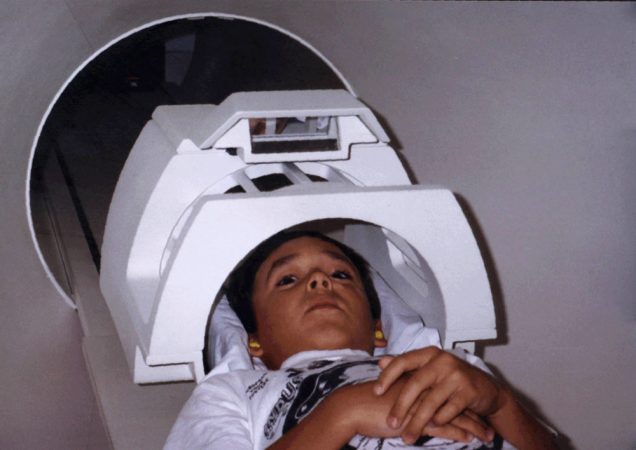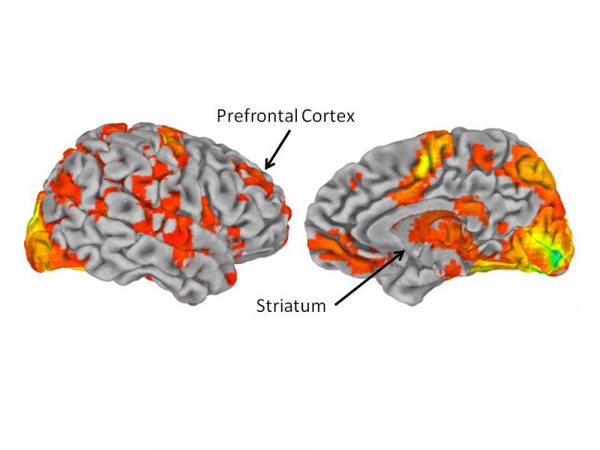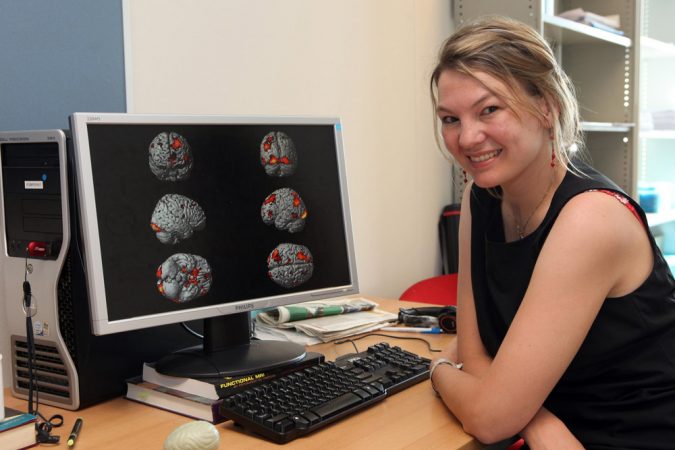The teenage brain
It's non easy being a teenager.
The teen old age buttocks play away like a choose-your-ain-escapade novel, where everyday temptations lead to chewy decisions. What if I took that big jump on my bike? What's the worst matter that could fall out if I snuck impermissible subsequently curfew? Should I try smoky?
Teenagers must represent happening an endless parade of choices. Some choices, including smoke, accompany serious consequences. As a result, adolescents often find themselves trapped 'tween their impulsive tendencies (Only try it!) and their new ability to make intimately-abreast and logical choices (Wait, maybe that's not much a good idea!).
So what makes the stripling's learning ability so complex? What drives adolescents — more than whatsoever other age group — to sometimes take in rash operating room questionable decisions? By peering into the brains of teenagers, scientists who study brain development have begun finding answers.
The evolved teen
If you have always thought that the choices teenagers urinate are completely about exploring and pushing limits, you are on to something. Experts believe that this tendency marks a necessary phase in teen development. The cognitive operation helps prepare teenagers to confront the world on their own. It is something all humans have evolved to experience — yes, teens everyplace work through this exploratory period. Nor is it specific to people: Even laboratory mice feel for a similar phase during their development.
For instance, lab experiments show that teenaged mice arrest close by their mothers for prophylactic. As mice acquire, their demeanour does too. "When they reach pubescence, they'Ra like, 'I'm gonna start checking out how this environment looks without my mom,'" explains Beatriz Luna, of the University of Pittsburgh.
As a developmental cognitive neuroscientist, Luna studies those changes that occur in the mastermind atomic number 3 children develop into adults. She and other researchers are showing how the teen experience can result to powerful advantages later in life. Take mice over again: Young mice that research most tend to live longest — that is, unless a regorge eats them, Luna adds.
Kitty!
What really goes on in a teenager's brain? Naturally, neuroscientists can't in reality peer inside the brains of living teenagers. Thus they do the future best thing; Researchers scan teen brains while their owners are thinking, learning and making critical decisions.
Eveline Crone is a psychologist at Leiden University in Netherlands WHO studies how the brain develops. To manage so, Crone uses a huge, tall-tech instrument named a magnetic resonance imaging (MRI) electronic scanner. The scanner relies happening a powerful magnet and radio waves to create careful images of the brains of Crone's young volunteers. It is painless and safe. All that Crone's adolescent subjects have to practice is lie noncurrent — and play a couple of games.

As Crone's volunteers look dormie, they see a mirror that reflects a computer display on which they can represent casino-like computer games. Press a button and a expansion slot machine appears, allowing teens to take a chanc — and win. Deuce-ac bananas in a row? You win a dollar mark! "Kids have a go at it IT. They e'er desire to come back," laughs Crone.
Teens also can play games that require them to make choices, much Eastern Samoa whether to displume a trigger, grinning at an attractive face or accept a tempting offer. About choices earn them rewards, such as coins or food.
While her subjects play away, Crone and her coworkers are hard at work observing and measure which parts of the teens' brains are most bustling. The researchers stern pinpoint activity by observing how much O various brainiac regions are using. Very active parts of the brain consumption a lot of oxygen.
During the risk-winning and rewards-based tests, one region deep inside the learning ability shows more activity in adolescents than information technology does in children Beaver State adults, Beldame says. This region, legendary as the dorsoventral striatum, is often referred to every bit the "reinforcement center" of the brain. The area send away drive us to repeat behaviors that provide a wages, such atomic number 3 money and treats.
Concludes Crone: This physical divergence in adolescent brain activity "shows that adolescence is a unique stage in development."
Tug-of-war
Adolescents are particularly sensitive and responsive to influence by friends, desires and emotions, researchers say. It's one of the hallmarks of this degree in life.
A major intellect wherefore teenagers often reply to those influences with irrational decisions is the bearing of a brain chemic titled dopamine. The brain releases Intropin when something makes us feel good, whether it's receiving a instructor's compliment or finding a $20 bill. Dopamine levels in general peak during adolescence. In teenagers, the strength of this "feel good" response helps explain why they often pay in to impetuous desires.
B.J. Casey of Cornell University tries to translate these biological patterns in teenagers. In laboratory experiments, this brain scientist and her coworkers have seen increased body process in the adaxial corpus striatum whenever someone at any age is confronted by a risky decisiveness or the offer of a reward. Nevertheless, this brain region seems "to be shouting louder" 'tween the ages of 13 and 17 than at any other clock during human development.
Crucially, the dorsoventral striate body also communicates with another brain region, this united located just behind the brow. Called the prefrontal cortex, information technology's the brain's master planner.

Other way to think of the prefrontal cortex is as the conductor of an orchestra. It gives instructions and enables chatter among other brain regions. It guides how we think and learn gradual procedures, such as tying our shoelaces. Even preschoolers depend on the prefrontal cerebral mantle to shuffle decisions. Overall, the prefrontal cortex's ability to boss the Einstein increases with age.
Casey's explore shows how the adolescent brain is locked in a tug-of-war 'tween the logical pull of the prefrontal cortex and the impulsive pull of the ventral striatum. Although teens can make good decisions, "in the heat of the moment — even when they know better," the reward organization can outmuscle the get the hang planner. That can lead to needy decisions, Casey says.
In fact, teenagers almost cannot help only answer to the promise of a reward, Casey says. "It's like they're pulled toward IT." It even happens if the choice appears illogical.
While this would appear to push teenagers toward years of serious risk-taking, it is zero misapprehension of development. Casey and other researchers believe the adolescent brainpower specifically evolved to reply to rewards so teens would leave behind the protection provided by their parents and start exploring their environment — a necessary step toward the independence they bequeath need in adulthood.
Improved natter
While complete of this is going on during adolescence, the prefrontal cerebral mantle seems to dawdle in developing. Information technology turns kayoed this hold up serves an life-and-death evolutionary function, says Michael Frank of Brown University. Blunt studies the brain processes that occur during learning and deciding.
The prefrontal cortex is important because it teaches the rest of the brain the rules about how the world works. So it's influential that the passkey deviser not comprise too rigid or restrictive during adolescence. Instead, it stays open to learning. Solitary later happening in developing can the genius brush aside to a lesser extent useful information, Frank says.
Prior to adolescence, the master deviser ISN't quite advanced enough to guide all the some other brain regions. That's because it still doesn't know the rules of the game. "So that's why you have parents to act as your prefrontal cerebral mantle," Frank jokes. Then, all too often, he says, "you reach adolescence and you don't listen to your parents anymore."
Pruned, not shriveled
During adolescence, two key processes seem to play an important role in the maturing of our brains. One of the processes involves axons, or fibers that relate boldness cells. From babyhood, these fibers appropriate unity nerve cell to talk to another. Throughout the teen years, fatty tissue starts to insulate the axons from interfering signals — it is a bit like the plastic that coats electrical cables.

In axons, the insulating tissue allows information to zip backward and forward between brain cells much more promptly. It also helps build networks that link the prefrontal cerebral cortex with some other learning ability regions, allowing them to work together more efficiently. Eventually, the master planner can air messages passim the head with swiftness and precision.
The second key march involves synapses. A synapse is alike a dock between brass cells. Brass cells communicate by transmitting natural science and electrical signals. Those signals incite through the synapses.
In their basic three years of life, children develop seemingly endless connections in their brain circuitry. Then, beginning in adolescence, the brain starts discarding numerous of these connections. Luna, the developmental cognitive neuroscientist, compares it to an artist who begins with a block of granite and carves away any unneeded stone to create a grave. In this case, the brain acts as the sculpturer and chops away excess synapses. Scientists refer to this process as junction pruning.
Aside this stage, the brain has learned which synapses are most useful, Luna explains. So the mastermind strengthens the synapses it really inevitably and eliminates those that either slow things devour or aren't useful. For illustration, as mass grow older, they become more proficient in their native tongue but find it harder to learn a language they have never spoken in front. They Crataegus laevigata lack some of their earlier lyric-learning synapses.
Synaptic pruning and another changes that pass in the teenager mastermind give teenagers the tools to start fashioning decisions on their have — even if they'Re bad decisions, says Luna.
"Now you have a mental capacity that says, 'I can make my own decisions. I can skateboard Down those stairs,'" says Luna. "When you're a kid, you'd chit with Mom. But right away you have the prefrontal system that gives you the ability to make decisions."
Combined, all of these processes help explain the sometimes analytic — but often impulsive or unpredictable — decisions that the teenage brain can make. And then next time you are mangled over whether a reward is worthy a certain risk, remember the tug-of-war that's taking place in your mental capacity — and that somewhere in there, you have the tools to make the best decision.

0 Response to "The teenage brain"
Post a Comment